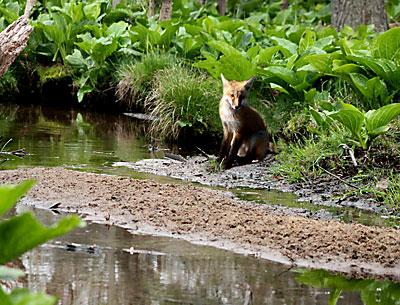Nature Notes 04.26.12

On April 10 I went with some friends to the meeting of the Long Island Botanical Society held at Stony Brook University. When we were approaching the campus from the north end of Nichols Road, a red fox streamed across the road from east to west with outstretched tail. When we arrived back at Warren’s Nursery in Southampton (our starting point), a red fox ran across Majors Path into the nursery, its tail in the same position. That made sense, there is an active den with fox kits at that site.
All evidence points to this being the year of the red fox. They seem to be everywhere, and always hurrying with tail straight out. If you go outside and smell what you think is the scent of a skunk, it’s probably emanating from a red fox. If you hear strange yelps in the night that you haven’t heard before, they’re probably being uttered by a red fox.
There has been an approximately 15-year hiatus between peaks in the fox population on the South Fork. Between 1994 and 1999 they were very common. Then the mange struck and the population was quickly decimated. Prior to that time, the last peak occurred in 1982, following which the mange knocked the their numbers down as if overnight. Thus it would seem that the fox population rises and falls in a 12 to 14-year cycle.
In the early 1990s when raccoons were as common as they are today, distemper hit them hard and until the start of the new millennium, their population remained down. For reasons unknown, our local population of opossums hit a low in the early 2000s, then sprang up to another high point by 2007. They and raccoons are still going strong today. All of our mammals, including gray squirrels, chipmunks, cottontail rabbits, voles, and shrews, have cyclic highs and lows, perhaps with the exception of deer, which continue to thrive from year to year.
In the old days we referred to these comings and goings as “the balance of nature,” a phrase that had gone out of fashion in scientific circles, while to us laypeople, the notion still holds water. Walk around on the average South Fork lawn and you sink in, the voles have been tunneling back and forth creating mazes of weaknesses in the soil structure. Why so many voles? Too few foxes!
Cottontails, although not nearly as common today as they were 60 years ago, when almost every yard had one or two, have been increasing in number while foxes were down. They have been held in check somewhat during the interim by red-tailed hawks; the number of pairs breeding locally has never been higher. We can expect to see cottontails’ numbers plummet now that Reynard is back in town.
Little foxes need meat, meat, meat, and lots of mother’s milk, prior to weaning come midsummer. Vixens have to work really, really hard to keep their young in good health until they are ready to go out on their own.
It will also be interesting to see what happens to the wild turkey population in the face of this spate of foxes. Like white-tailed deer, wild turkeys — reintroduced on Long Island after an absence of almost two centuries — have probably never been so common as they are today. Adult turkeys are a bit much for foxes, but poults are easy picking.
The red fox also enjoys a certain momentum that species invading new territories for the first time often exhibit. Our red fox and the Eurasian one are practically synonymous, you can’t tell one from the other by their looks. The North American red fox came from Asia (but was also later imported from Europe by fox hunting enthusiasts), probably at about the same time Asian humans arrived here. It probably happened during the last ice age when the seas were hundreds of feet lower than they are today and one could practically walk across “Beringia,” the icy land bridge connecting Siberia with Alaska.
Long Island’s common (and, maybe, only) fox in pre-Columbian times was the gray fox, a small number of which persist here today, particularly so in the Central Pine Barrens but also in Montauk. Once established in Alaska and western Canada, the red fox spread quickly throughout the rest of North America, then down into Central America, and from there into South America. Its population is still expanding. Until something happens to dramatically lower the red fox population on Long Island for a very long time, the gray fox will have to play second fiddle.
Global warming will probably not affect the red fox population as the species has adapted handily to living in the tropics. Indeed, it might be the other way around. Frigid winters are largely responsible for doing in mangy foxes as they are left with little fur to insulate them from the cold. Some mangy foxes may be able to eke out an existence during a mild winter such as the one we have just experienced.
Let’s keep an eye out to see what happens.
